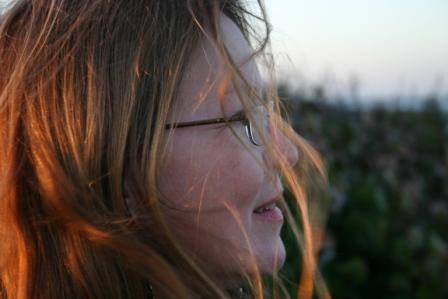
Herewith a delightful What It’s Like Living Here piece from Lisa Roney in Orlando. This is our second contribution from Florida in recent weeks, a sign that all the writers are moving there (well, maybe not). Lisa Roney teaches writing at the University of Central Florida. She is the author of a memoir, Sweet Invisible Body: Reflections on a Life with Diabetes (Henry Holt, 1999), as well as poems, essays and stories. She had the eminent good sense to marry a Canadian.
dg
.
PPelicP.
Birds
I live in the sky. Though it is crisscrossed with wires and impeded by billboards that sell big-breasted waitresses at the Wing House, it still dips its bruises in gold, not brass, then blushes at its own riches before waving good night. As I drive from yet another late neurology appointment along one of many six-lane roads that traverse the city, I search above it all, let the fading light guide me home.
Beyond the billboards, the barbequed chicken wings give way to the wings of hawks, eagles, herons, egrets. This evening eight ibis circle stunningly white against the blue, blue sky over the roadway, catching the last light of the day. Last week two bald eagles swooped ten feet above my head as I strolled my neighborhood. Cardinals and titmice flutter around the feeder in front of the kitchen window at morning and dusk, while the barred owls show themselves after midnight in their hilarious song. My husband and I lie in bed sometimes and mimic their “whoo, whoo, hah, whoo-who-oo-ahhh.” It helps my insomnia when my heart is lightened this way at bedtime.
The anhingas even bring sky to the ground, as they sit lakeside with their wings outspread to dry, as if flying on earth. The birds are my favorite thing about Florida..
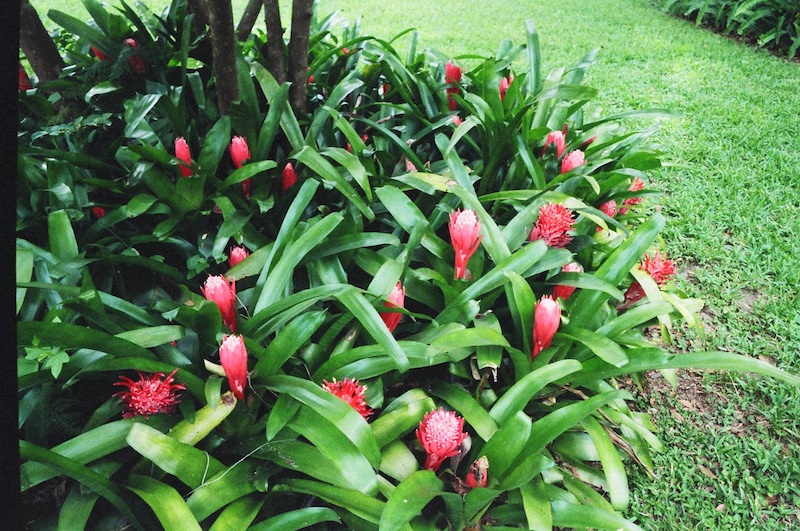 Bromeliads with Red Blossoms
Bromeliads with Red Blossoms
.
Winter Park
The first summer it rained and rained. In between the thunderstorms, I waited for my new job to begin and went on rambling, hours-long, solitary walks in the chic neighborhood near my homely concrete-block rental. One morning as I typed at my computer, I glanced to the right out the front window and faced a four-foot-long snake wending its way through the bromeliads under the orange tree.
At the time I didn’t know the name of bromeliads. I said to myself, “It’s only a black snake. Cool.” But it might have been an omen of the unpredictable. I find later on that it is indeed adaptive here to enjoy the same creatures that you fear since you can’t get away from them.
 Hospital Heart Monitor
Hospital Heart Monitor
.
Medicine
Orlando is home to two of the ten largest hospitals in the country, and one of the three Mayo Clinic sites sits on the coast an hour north in Jacksonville. This does not assure anyone’s good health—probably CEOs chose our locale for the aging (and dying) population of retirees that Florida is famous for. I myself came here young and immediately hit the wall of numerous health problems, as though crossing the border into the land of retirement infected me with oldness.
I came here with thirty years of Type 1 diabetes under my belt already, but my list of ailments has blossomed like a bougainvillea, taken flight like an enormous eagle: carpal tunnel syndrome, adhesive capsulitis, irritable bowel syndrome, rosacea, arthritis of the right foot, lumbago (only one letter different from the purple-blooming plumbago that I had never seen before coming here). The human body is part of nature, though certainly denatured by all the machines now engaged in being sick. In the past two years, I have endured a benign perimescenphalic sub-arachnoid brain hemorrhage and, supposedly in a completely unrelated set of incidents, inflammation of my brain pathways that may indicate M.S. After six months of testing, they don’t really know.
Even though I don’t really want to talk about them, I cannot separate these things from what it is like to live here. The uncertainty seeps out of my skin like the constant sweat of summer.
Everywhere you go in Florida, there is a stark contrast between young and old—the stooped and graying alongside the tanned and buff, the slowest drivers in the world alongside the Daytona 500, the shops for orthopedic shoes alongside the surfin’ bikini boutiques.
For most of us, living in Orlando is like living somewhere in between.
 Green Anole
Green Anole
.
Heat
Our summer is our winter. Not that summer’s cold, as in the northern-southern hemisphere switch, but in that we, too, have a season where we stay indoors, protected from brutal weather by our air conditioning. According to the National Weather Service, more people die from heat than from any other weather-related phenomenon, including floods, lightning, tornadoes, and hurricanes. More than three times as many die of heat than cold.
One of the big differences between people who visit here and people who live here is that we are aware of the nastiness of the heat. Everyone stays outside a lot in December, January, and February. But we hide in June, July, and August, and we sweat profusely nine months out of the year.
Earlier this afternoon, as I walked into the doctor’s office, a woman made a face and said, “I fear the spring is over.” We bask in spring, but dread the oppression of summer and fall, the threat of hurricane season.
Everyone in Florida carries a bottle of water. I first came to realize the Floridian devotion to hydration when I noticed that my students would sometimes get up during classes to go out and use the restroom. That is as accepted here as students blowing their noses in class in the north.
In fact, most of the people who die of heat exposure do so in milder climates where so many of the elderly still believe they can live without air conditioning. Down here, we know we can’t. If this makes me wonder why it is that people insist on living in such inhospitable places, I put it out of my mind. If I wonder, as I idle in traffic on my way home from the doctor’s office, why humans have designed their world to be such an ugly and hostile place, I remind myself that the black lady standing at the bus stop on Route 434 with her umbrella up against the sun probably doesn’t have the luxury to worry about it and neither do I, really, not these days.
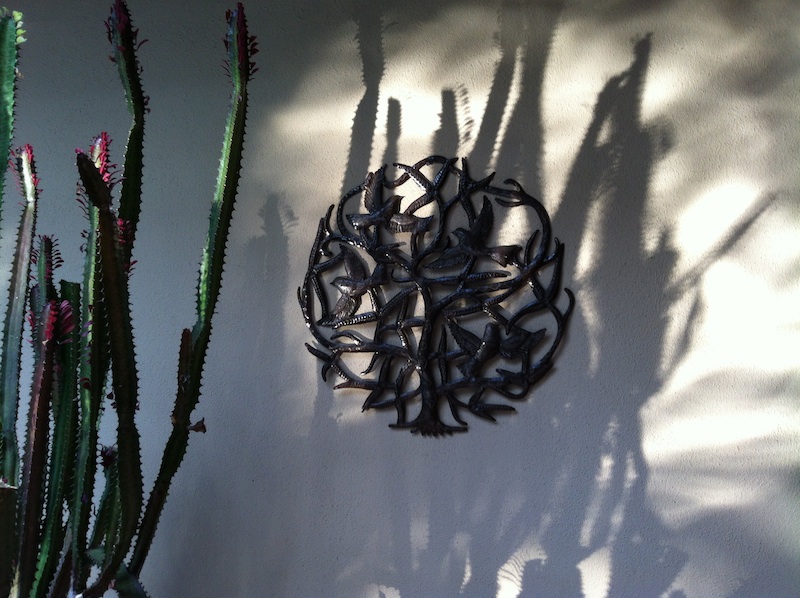 Sunlight on Wall with Euphorbia
Sunlight on Wall with Euphorbia
.
Winter Springs
Six years after coming here, I got married and moved to the suburbs, not necessarily in that order. Both of these facts surprise me, and I feel guilty for liking everything about the suburbs but the political tenor and the car-time. Besides, everyone in Orlando drives a lot, no matter where they live. When Men’s Health magazine reported that Orlando is one of the angriest cities in the country because of the traffic, I just nodded.
My new husband cackled. A Canadian, he declares America barbaric. “In Canada,” he often reminds me when we’re together in traffic, “we understand the concept of merging for mutual benefit. Here everyone races to the front and tries to jam their way in.” I assure him that the entire country is not like this, but I feel the shame of American greed.
My own backyard reeks of stereotyped paradise, yet I love it almost as though it were my very own forever home. I was broke for a long time. Now the fountain bubbles, the cats roll on a bricked lanai, tall palms and pines line the fence, and two Adirondack chairs sit by the pool. I swim almost daily, though I did not want a pool and I am a terrible swimmer.
“Why else would anyone live in Florida?” my husband asked when I protested. I am not sorry I acquiesced.
I like being married after 49 single years and hope I still have plenty of years to enjoy it. I find it freeing to be tied. Once I thought I came here for the job at the big school over the previous small one, the moderate-sized city over the small town. Once I thought I would seek perfection until I found it and that excitement would always be mine. What a delight that I was so wrong.
 Agave Stalk and Telephone Pole
Agave Stalk and Telephone Pole
.
Plants
Because flowers bloom year round here, and because there are few cemeteries, it can be easy to forget that the life cycle ends in death. When I get home, I pull my car into the garage and stand in the driveway, breathing in the aroma of the confederate jasmine I planted along the fence last year. I check on the new herb garden that is spreading exponentially, the way things do here. Finally, I am growing things.
It took nearly three years for me to plant the gardenia that a friend brought to our wedding, and it now has buds nearing bloom. All the other gardenias on the street parade massive, fragrant flowers, but I am thrilled simply that ours is still alive, gardenia and marriage both surviving overwork and hospital stays. The staghorn fern that another friend brought as a wedding gift hangs from a tree in the front yard. On cold nights, the neighbors down the street wrap their huge staghorn in blankets, whereas ours is still small enough to drag in the front door. I wonder if the enormous one down the street testifies to a long marriage and whether ours will get that big.
I have also put into the ground three offsets from an agave that grew in my Winter Park yard. These are an exception to the ever-blooming of most tropical plants. They bloom only once—on a stalk that appears overnight as tall as a telephone pole—and then wither into a heavy stump.
Finally, after the agave amazed me with its theatrics, I started to learn the names of more common plants: saw palmetto, sago palm, bougainvillea, bromeliad, bald cypress, mangrove, ligustrum. We have plumbago, shrimp plants, lorapetalum, and camellias growing in our yard. Knowing the names is almost as important to me as growing them, but I am glad to have reduced the amount of evil St. Augustine grass by half. St. Augustine grass is another one of those peculiar Florida phenomena—a non-native plant ubiquitous for lawns, it tolerates the heat but soaks up ridiculous amounts of water.
The hummingbirds will come to our new fire bushes and spicy jatropha. My newlywed husband will be here tomorrow in spite of my surprise brain hemorrhage and the lesions that could render me crippled or dopey. I will still be able to walk around and deadhead the flowers for some time. That is enough, along with the jasmine, for today.
 Why I Live in the Sky
Why I Live in the Sky
.
Whorelando
The corporate tagline for Orlando is “the city beautiful,” but we have coined the moniker Whorelando, or, in a more Spanish spelling, Jorlandó.
Though it still asserts itself over and over, the beauty of Whorelando is for sale and disappearing fast. I have never seen more strip malls anywhere. When I originally looked for a house to rent, I clicked excitedly on an online ad for an “historic” home, only to find that it was built in 1950. Whorelando is full of concrete block and bulldozers.
I moved here nine years ago and have lived here longer than nearly anywhere in my adult life, yet it still feels alien. Like the narrator of William Gass’s short story, “In the Heart of the Heart of the Country,” I am not of the people, not of the place. Like that narrator, I’ve had my disappointments.
On one of my first drives to work here I watched a man, a bag of McDonald’s on his handlebars, a case of Coke strapped behind his seat, cycling alongside the traffic, his long, grey hippie’s beard and locks flowing in the warm breeze, his pale face grizzled with dirt. Weird is everywhere I look. Sometimes it is the weird that is ultranormal—the made-up housewives with pink sweat suits and boob jobs, the nurse that says my survival is a gift from God, the sleepy kids lining up for the school bus.
I am in the heart of the heart of the heart of the peninsula, land-locked in a state full of beaches. We should get out to the coast more often.
 Bougainvillia
Bougainvillia
.
Disney
Friends and family fly in and stay with us while they visit the “attractions.” Everyone thinks that if you live in Orlando, you live close to Disney, so they are always surprised that we live an hour’s drive away.
I have not been to Disney World since 1972, although I have had Pluto in class, and my husband, Cinderella.
 Gator in Pond
Gator in Pond
.
Sanford
A few weeks ago, Trayvon Martin was shot and killed on a street in the town just across Lake Jesup from where we live. Orlando boasts tourists from all over the world, but just over the lake, whichever lake, there is a dense scrub of raw lawlessness and backwoods sensibility. Trayvon Martin’s death by vigilante is the tragic other side of Peter Matthiessen’s Killing Mr. Watson, in which an Everglades community bands together to murder a greedy bully. Something constantly threatens to be out of control here—the crime, the law, the lawless order, the construction development, the real estate boom and the real estate crash, the bougainvillea vines, the wind, the rain, the heat, the humidity, the drought, the Cuban tree frogs, the alligators.
Lake Jesup is full of alligators, and sometimes during mating season they come down through the creeks and end up in the retention pond across the street from our house. An eight-foot one took up residence the week before we got married in the backyard. “That just makes it a Florida wedding,” my vet’s receptionist told me.
My friends warned me before I took this job—about the fundamentalist Christians who objected to any mention of Halloween, about the hurricanes, about the gators and the palmetto bugs, even about rampant entrepreneurialism, capitalism gone jungle-feral. Some of them have cut me off because I came here. Some others have kept in touch for the vacations. I understand both impulses.
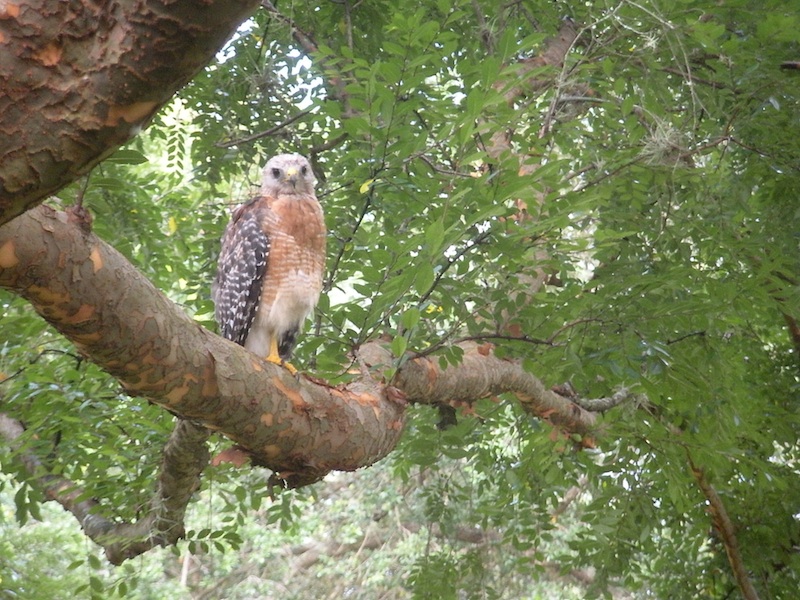 Hawk
Hawk
.
Rain Storms
After I come in from breathing jasmine air, I find an email informing me that my teaching schedule for next year is in disarray. I spend a moment furious, but it’s the usual way of things in a state with a legislature intent on destroying educational institutions that have only ever had a toehold anyway. The governor just approved creation of a brand new state technical university, with the budget coming out of those of existing schools. Rumor has it that the legislator who sponsored this new school stands to make a killing on nearby real estate. All that valueless swampland once sold to unwitting northerners is now valuable after all.
The next morning, clouds finally move in after more than a month with no rain. We’ve reveled in the sunshine, but the splatting drops on my morning walk break the tension. By afternoon, it will be pouring off and on, and the smell of ozone will waft in through the open sliding glass door as I sit at the computer. I will stay home cozy with my husband in the evening because going out during rain here means getting soaked. We will watch for the neighborhood red-shouldered hawk, who often comes down to the low branches in the rain.
A friend down in Tampa says that she hopes the rain will come their way, though she hopes she doesn’t regret wishing for it once the rainy season socks itself in for the duration.
“Sunshine State” is another misnomer around here. It rains constantly most of the summer.
My first year, I ruined six pairs of shoes by getting caught in unexpected storms. Now I just take my shoes off and smile when I walk barefoot into class or a meeting. Bare-assed, barefoot—I’ve learned to live with both conditions in my professional life.
The second year I was here, three hurricanes marched through Orlando. “They never come this far inland,” a Florida native friend had said. I lay in the hallway of my rental and listened all night as the huge live oaks thundered to the ground in pieces. I thought, this is what the apocalypse will feel like.
 Raccoon in Humane Trap
Raccoon in Humane Trap
.
Winter Springs Redux
A neighbor told me that her family had installed a new security system for fear of home invasion. Later, after Trayvon, she mentioned that her mother warned her son not to wear a hoodie. I don’t know how to feel about that. Orlando has one of the highest murder rates in the country, but violent crime is concentrated far from where we live, and I find suburban fear rather silly, a little racist. As a white teenager, our neighbor’s son is in little danger. But I am glad that the grandmother sees the absurdity of Trayvon’s death enough to feel the fear herself.
For me, the more salient neighborhood concern is the possibility that I might run over an animal. Though the plants seem to bloom forever, the area is strewn with road-kill. Squirrels feed in the right-of-way, jerking their tails and dashing, often right into the street, when I pass. When one is killed in the street in front of our house, I am glad that the bald eagle that flies in to rip it apart first pulls it into the yard across the street, where it will be safer from cars.
The residential hawk, grabbing an anole, swoops down and pulls out the neighbors’ window screen. My husband tells them so they won’t think it’s a robbery attempt. Anoles dash across the sidewalks, but their squashed bodies are nearly as common as their flickering live ones.
The raccoons take to tearing the screen out of the lanai, pooping in the pool, letting the cats out. We catch a raccoon swinging from the squirrel-proof birdfeeder, back and forth, unhooking it and dumping the contents. We humanely trap and relocate two and an opossum in three days, but more come back. We install a raccoon baffle on the bird-feeder. We install super-strong screens. Then we glue them in.
The armadillos dig up the front grass looking for worms and grubs. When I drive home after dark, four or five cross the street in front of my car. I know they are ready to leap straight up into my bumper.
Maybe living in more urban areas allows other people to forget that they are supplanting so many other forms of life. Here in the suburbs, we can never forget. An uneasy cohabitation prevails. I love the critters, and perform the sign of the cross as I drive by their corpses, but we also battle them.
Over dinner after the clarifying rain, I admit to my husband that maybe Orlando is indeed the quintessential American place—teeming, insane, unstoppable. For better and for worse, I tell him and wink. Probably the future doesn’t look too good, but I have seen amazing turn-arounds happen in my own departure from spinsterhood and my survival of my brain ailments. I have some hope that, after all the people are gone, Florida, if it dies by flame and not by drowning, will rise from the ashes. It seems at least the most likely place for resurrection.
—Lisa Roney
 Magnolia Blossom
Magnolia Blossom
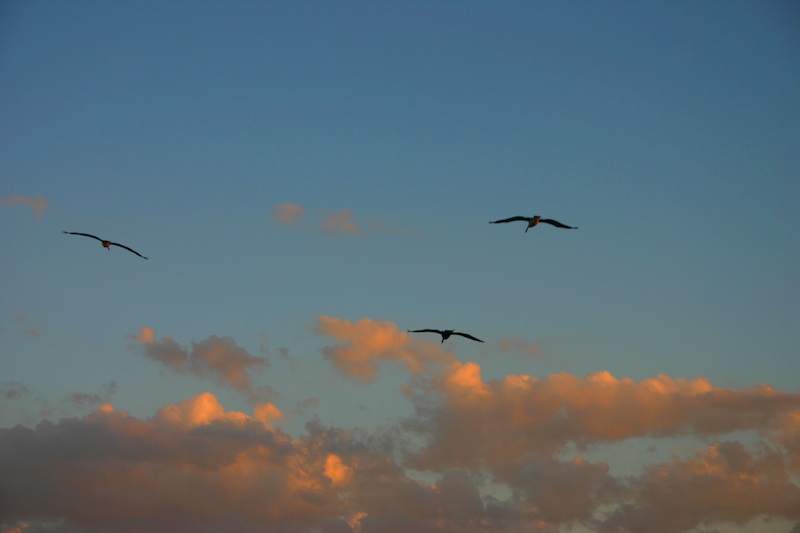
Beautifully written, Lisa! As an “alien” who moved to Florida some 10 years ago, I still vacillate between reveling in the smell of jasmine, the green of sweet potato vine, and ruing the day I left the beauty of NC mountains for sand, flatness, and humidity.
Thanks, Steve. I’m sure there’s another whole essay in there about the native v. non-native divide in Florida. One thing I like about it, however, is that you always notice you are somewhere in particular.
Today in St. Louis, Missouri began on the cool side of 70s and damp from the rain of last evening. Thanks for those wonderful pictures. Blessed us with more. rjohnson@stlcc.edu
I’m on my way….out of the snow banks of Maine, the rain season and mud. Tossing aside the LL Bean clothes for flip flops and sun block….I’m coming to Orlando in August…If I survive the heat of that month, I’ll live to enjoy fresh strawberries, oranges, and grapefruit. I will raise a glass of wine instead of the handle of a snow shovel.
Thank you for writing this. I am about to embark on a move to Orlando from North Georgia. My biggest fears are the loss of leaves in the fall…hills and cool weather. You paint a beautiful picture of not replacing those but filling them in with items unique to central Florida.